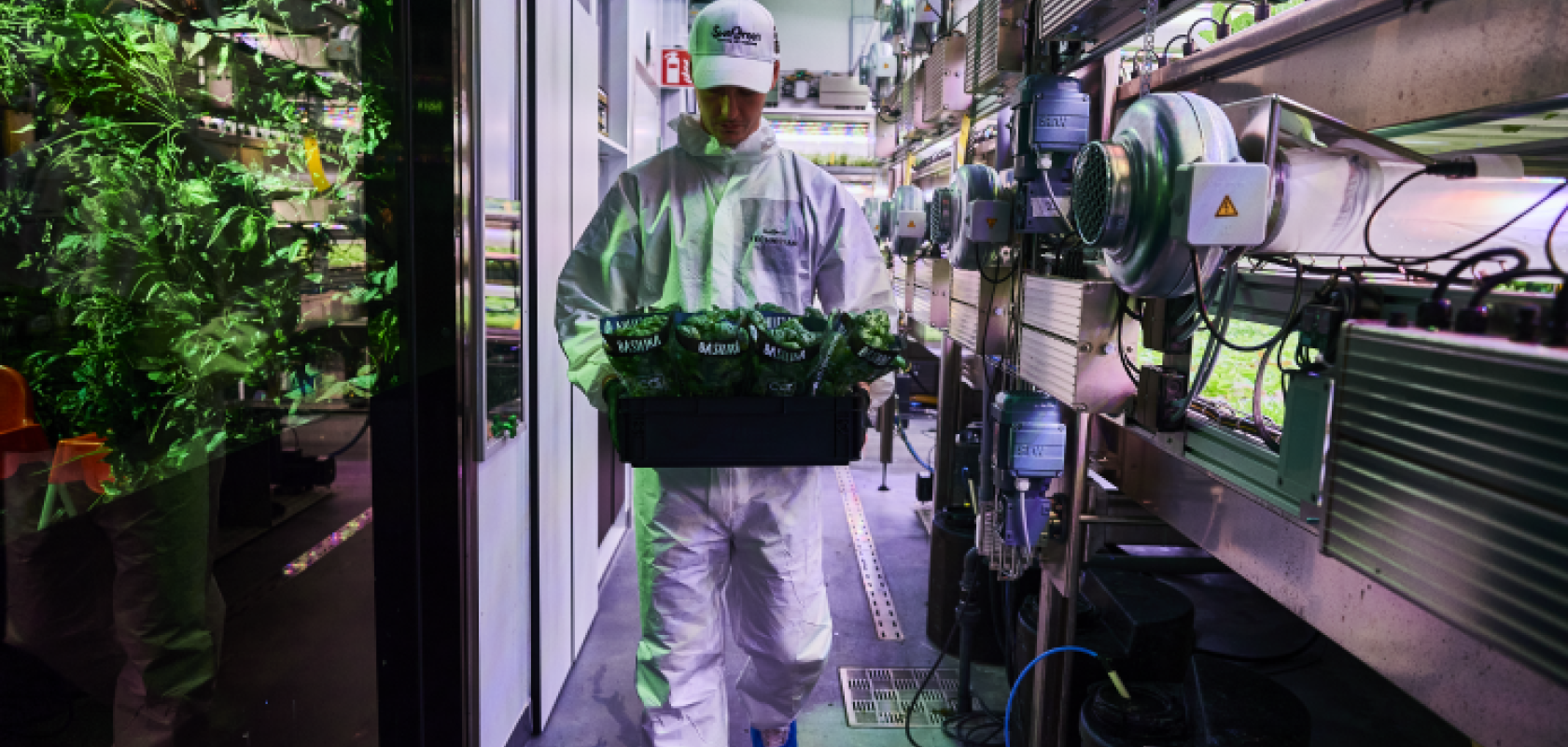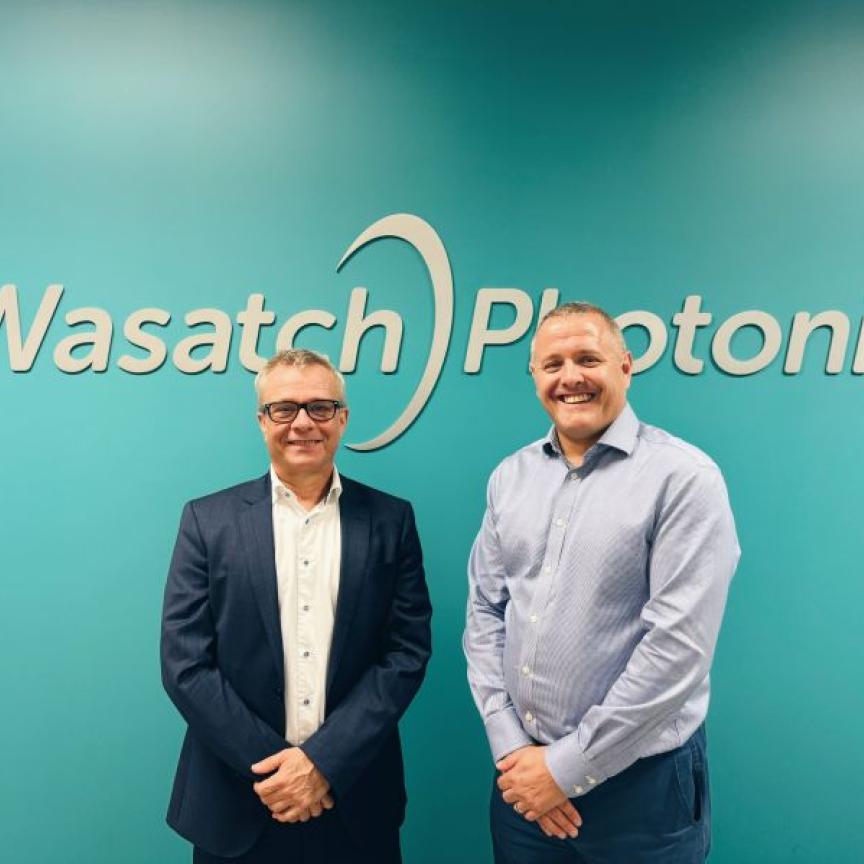How does the world feed its ever-increasing, evermore urbanised population in a sustainable way? This is the question vertical farming aims to answer.
In vertical farms, plants are grown in vertically stacked layers as opposed to horizontal rows, fields are replaced by abandoned indoor spaces, a hydroponic fluid medium usually takes the role of soil and rain, and LED lights do the job of the sun.
Farming in this way has many advantages. The most obvious is a much smaller footprint. Done well, vertical farms can increase yield by over 10 times per acre compared to traditional farms.
When placed in prime urban or semi-urban locations, they also reduce average food miles from around 1,500 miles for a traditional farm, to just 43 miles for a vertical one. What’s more, their controlled indoor growing environment means vertical farms are not plagued by pests and are naturally resistant to unfavourable weather – an increasing problem as the effects of climate change become more apparent. And they are not bound to the seasonal and diurnal cycles either, meaning they are productive 24/7, 365 days a year.
Thanks to these and other benefits, the vertical farming market has rapidly grown over the last decade, with the trend set to continue at 25% CAGR for the foreseeable future and a huge range of start-ups, scale-ups and even now unicorns – US-based Bowery Farming, AeroFarms and Plenty, and German company InFarm – ploughing their own unique furrow.
Energy intensive
So, why aren’t our urban and semi-urban areas bursting with fresh produce? Aside from the fact that vertical farming is largely limited to the production of herbs, leafy greens and microgreens at the moment, the main reason is cost. Investment and personnel costs are a part of this, but the biggest cost that makes growing produce on vertical farms both economically and environmentally less sustainable than in greenhouses or on traditional farms is energy use.
“About 50-70% of a vertical farm’s energy use is coming from lighting: the LEDs,” says Professor Leo Marcelis from Wageningen University, The Netherlands. “And most of the rest is for cooling, which is also indirectly related to lighting.”
LEDs are inherently more efficient than conventional fluorescent grow lights, but the technology is nearing its maximum efficiency in terms of converting electricity into light, so there is little opportunity to reduce costs through fundamental development in that direction.
This is why researchers and companies in the space are concentrating on other ways to optimise LED lighting solutions. For example, UK-based Light Science Technologies (LST) launched its NurturGrow LED lighting range in 2021, an interchangeable design that is 90% recyclable and enables growers to upgrade components as necessary, instead of bearing the cost of replacing entire lighting systems every few years and sending waste to landfill.
Maximising efficiency
Another way to maximise efficiency is by focusing on the heat from the lighting solution. This affects the temperature of the plant, which in turn affects their development cycle. Deploying a centralised and remote power solution provides maximum control over temperature and strongly reduces the need for additional cooling within the growing area. And incorporating customised HVAC systems for heat dissipation and recycling, of which there are many ingenious solutions, can maintain optimal temperatures while reusing the heat elsewhere.
What can have the most impact though is ensuring plants make the most efficient use of the light they receive. The light spectrum, intensity and duration, and lighting position, all have direct effects on plant growth cycles and resulting produce.
Having experimented with many of these factors, Marcelis knows just how complicated it is to find the optimal lighting set-up for a vertical farm. In terms of light spectrum, a large fraction of red appears to be important for growth of any plant. But a touch of blue is also key to nurture vegetation and flowering, which is why most vertical farms are bathed in a pink-purple glow. Green can also play a part in some cases, UV can change leaf colour, and far-red light – traditionally thought not to be important for photosynthesis – triggers a wide range of important processes.
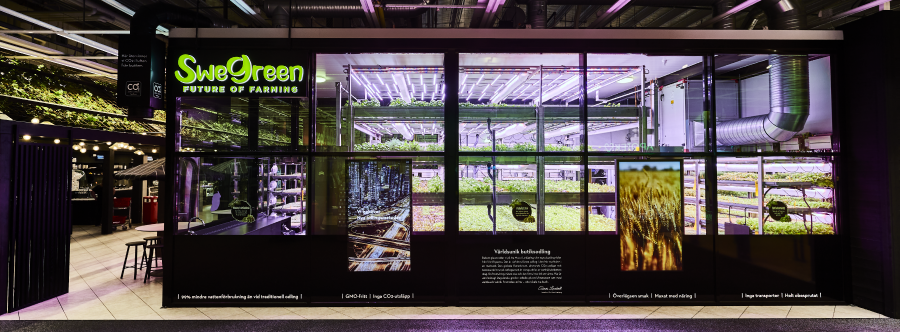
Marcelis has also found that plant yield is substantially affected by light intensity and duration. Higher intensities and longer durations yield more produce, but only up to a certain limit, which depends on the crop in question. Light intensity also affects produce quality and shelf life. “For instance, we have done experiments with lettuce where, in the last six days before harvest, we increased the light intensity very strongly,” he explains. “We saw there was more sugar content and vitamin C concentration in the lettuce – important for the plant itself and in particular for the shelf life, which went from something like nine to 13 days.
“What most companies do is keep everything constant throughout the whole day and throughout the whole growth cycle,” Marcelis continues. “We say, they should look at the growth stage and adjust the spectrum, intensity and duration to balance all of the factors that go into producing a premium quality product.”
A company thinking along similar lines to Marcelis is Swedish start-up, SweGreen. SweGreen operates eight vertical farm units (about 40-60m2) across Sweden and further afield. The company is also introducing new growing platforms with just a 5-8m2 footprint that could enable 80% of European supermarkets to offer store-grown vegetables to their customers. “Lighting is one of the tricky parts where we have done a lot of research to create a ‘recipe’ that divides into different phases of plant growth: when they’re smaller, when they’re moved from a nursery unit to our automated growing platforms; and then the last days where we’re really focused on taste adjustments and maximising biomass,” says SweGreen co-founder and Chief Innovation Officer, Sepehr Mousavi. “By implementing this recipe, combined with a smart timing and dimming strategy, we have been able to bring down our energy consumption by 20-25% per unit.”
Like most companies in this space, SweGreen keeps its lighting recipe a closely guarded secret. What Mousavi is willing to share is that it was not easy to find the right LED technology to deliver this recipe. “We went through a Finnish LED manufacturer, a Swedish one and then we finally went with an English company that could meet our requirements,” he reveals.
Using the right LED ‘recipe’
One of the most prominent LED lighting providers in vertical farming is Signify, a spin-off of Dutch multinational electronics company, Philips’ lighting division. Signify’s GreenPower LED production module provides high light output and wide beam optics tailored for vertical farming, and can be combined with the GrowWise Control System to implement pre-existing light recipes or create new ones. It has been used by well-known vertical farming companies such as Planet Farms, based in Italy, US firm Kalera and Japanese business Innovatus.
Among Signify’s many competitors, US-based GE Current stands out. GE Current’s Arize Life LED fixtures are installed at Fifth Season’s 60,000 sq ft pilot facility in Pennsylvania, USA, and have been selected by Jones Food Company for their 148,000 sq ft facility, JFC2. Currently under construction near Bristol, UK, JFC2 will employ close to 50km of Arize Life fixtures in the company’s bid to become the world’s largest vertical farm.
Though the LED lighting market is saturated by a host of companies – from generalists like Signify, GE Current and Chinese firm Sanan, to smaller indoor farming specialists such as UK-based Kroptek and LST, and Finnish business Valoya – opportunities abound for photonics innovators interested in expanding into vertical farming. This is because all signs point to vertical farming becoming fully autonomous in the near future. And for that, growers will need data from a raft of optical and other technologies.
Achieving full automation
At a small scale, US start-up Iron Ox has already achieved the feat. Its hydroponic farm relies on two robots, one of which picks up the trays of plants and transports them, while the other – in the form of a robotic arm – conducts fine manipulation tasks like seeding and transplanting.
But full automation is still out of reach for commercial vertical farms at present. The Netherlands is a hub for innovation towards making this a reality. For instance, the Amsterdam Institute for Advanced Metropolitan Solutions has teamed up with Wageningen University and vertical farming company, Growy – as well as various innovators such as Signify and Be-bots – in the GrowX 2.0 project – which aims to build an efficient, fully robotised and AI-driven vertical farm in Amsterdam. There, the researchers are testing robots that harness AI and machine vision to plant, nurture and harvest leafy greens.
Detailed plant monitoring
Elsewhere, Italian start-up Agricola Moderna is at the forefront of efforts towards continuous and detailed plant monitoring – key to full automation. Their platform uses several types of sensor – RGB-D cameras for canopy 3D reconstruction and several environmental sensors that measure temperature, light intensity and CO2 levels – and sends all this information to a central database where it’s analysed and given context. Agricola Moderna is also testing the utility of hyperspectral imaging.
By recording hundreds of bands across a wide spectral bandpass simultaneously, hyperspectral imaging allows the identification of materials based on their chemical composition, rather than their visible characteristics, such as size, shape or colour. “With a hyperspectral camera, we are able to capture a material’s unique spectral fingerprint,” explains Minna Törmälä from Specim, which produces the Specim FX10 hyperspectral camera Agricola Moderna chose for their studies.
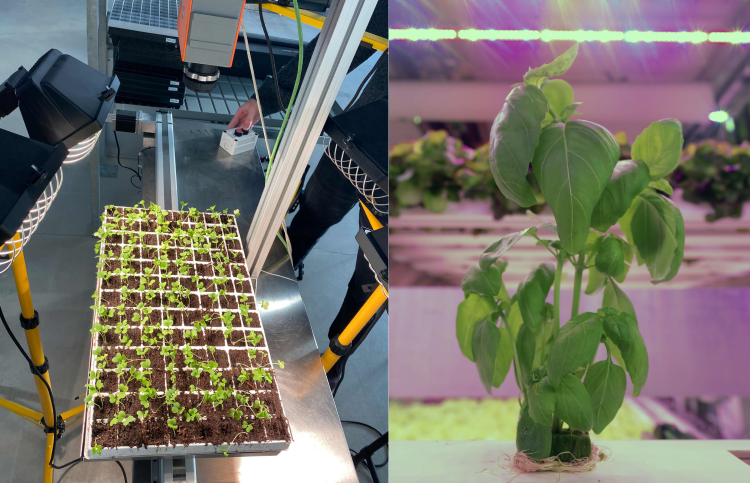
Left: Specim’s hyperspectral camera can capture changes in leaf pigmentation or the presence of macro elements such nitrogen, phosphorus and potassium. Right: Vertical farming tends to focus on growing herbs, leafy greens and microgreens at the moment
Imaging in the visible to near infrared (400 to 1,000 nanometres), the Specim FX10 can accurately capture changes in leaf pigmentation, the presence of macro elements such nitrogen, phosphorus and potassium, or the level of anthocyanins – pigments found in blueberries and raspberries, but also other plants – little to none of which could be gleaned from RGB cameras. “Simple algebraic combinations of the reflectance values at specific frequencies enable users to reliably monitor parameters and nutrition values, minimise energy consumption and water use, and predict the harvesting season and yield,” adds Törmälä, who points out that other Specim products delve into even greater detail: “If you want to study the mesophyll cell structure, for example, that requires 700 to 1,300 nanometres, which can be done with the Specim FX17 camera (range 900 to 1,700 nanometres).”
The future of hyperspectral imaging?
SweGreen is also interested in hyperspectral imaging. Teaming up with Mälardalen University, they are midway through a project that is investigating the use of hyperspectral imaging cameras to reveal plant responses to different lighting conditions, nutrient concentrations, irrigation-related stresses and other growth parameters.
But this is just one part of SweGreen’s vision for the future. “We want to add to our automation and use more robots,” says Mousavi. “If we could use vision diagnostics more, if we could read the signals of stress and distress, if we could create KPIs on the performance of the plants, and if we could also go deeper into how the look of plants impacts quality, it would be a perfect thing.”
SweGreen, Agricola Moderna, Growy and indeed most vertical farming innovators are all aiming to achieve the same feat – using a raft of sensing technologies that generate data for an intelligent closed-loop vertical farming ecosystem that optimises productivity and quality while driving down operational costs. Whoever gets it right will reap the rewards and start the “new vertical agriculture revolution” Google’s Ray Kurzweil predicted back in 2013.
--
Sponsored Case Study: Precision crop control with spectroscopy
A growing population and climate change directly impact agriculture and horticulture. An increasing number of people need to be fed, but changing weather patterns can cause complete crops to fail. It offers endless possibilities to improve the future of farming. This article highlights one of those possibilities; precision crop control. Spectroscopy has become an indispensable technology in agricultural applications and contributes to increasing efficiency, reducing time and optimising production.
Precision crop control
One possibility is precision crop control, which is observing, measuring and responding to the crops. By doing so, farmers can give them exactly what they need for optimum health and productivity. Precision crop control consists of many applications in which spectroscopy plays a key role.
Plant health monitoring
Spectroscopy in disease research
Plant health is essential for farmers, as it directly affects yields. With the help of spectroscopy, it’s possible to detect plant diseases early on and prevent spreading.
Near-infrared (NIR) spectroscopy is a cost-effective and accurate method for detecting diseases at the leaf and canopy levels. For example, Rice Blast Fungus is considered a significant threat to food stability due to the severe yield loss it causes, and until recently, involved a time-consuming physical inspection on the ground. With NIR spectroscopy, the correlation between the Rice Blast disease index and infrared spectra can lead to early detection. This enables more efficient use of pesticides and sustainable crop management.
Spectroscopy in handheld devices
A handheld device can measure leaves directly using reflectance, absorbance and transmission spectroscopy. The device shows real-time data, providing valuable information about various plant health parameters, ensuring early detection of plant diseases.
Such devices can be applied in greenhouses and integrated into robotic arms in vertical farming.
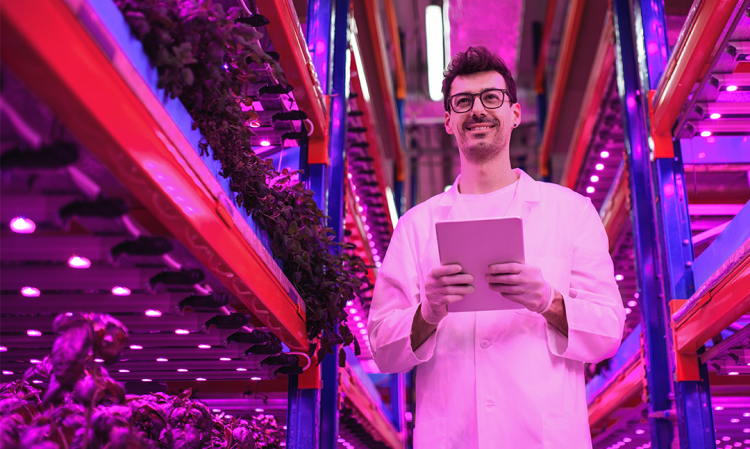
The application of spectroscopy in agriculture and horticulture stretches a long way and has a place in every step of the cycle
Spectroscopy integrated in modules and machines
To optimise functionality, spectrometers can be integrated into other measurement solutions. A great example of integration is from Yara International ASA. They created the N-Sensor, a module that attaches to farm tractors with fertiliser applicators. They apply spectroscopic diffuse reflection, ideally suited to this application, Precision crop control with spectroscopy – the future of farming SPONSORED: SUSTAINABLE FARMING as it requires limited hardware and performs at a very high speed. The module measures solar illumination and correlates this with reflection data from the crops. This data provides rich information about the chlorophyll content, allowing for the derivation of a health score. This score regulates the fertiliser application level in real-time and maps this to GPS coordinates for future monitoring. The module monitors crop health and also contributes to sustainable soil management.
Quality control
Crop quality is another area where spectroscopic techniques can be implemented. Researchers at the Polytechnic University of Valencia used an Avantes spectrometer to develop a mango quality index for prediction modelling. They also created a robotic gripper capable of simultaneous tactile and NIR measurements to determine the mango’s quality and ripeness.
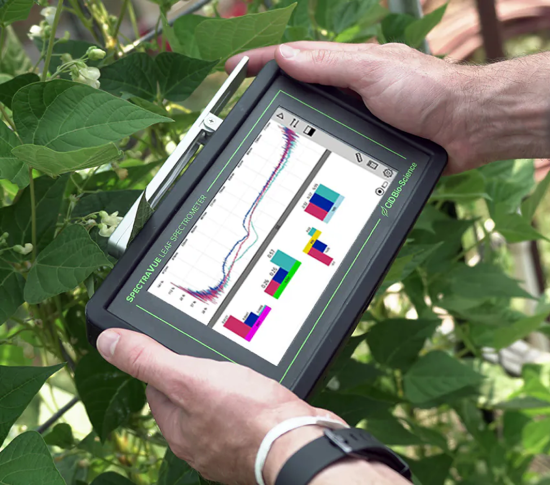
CI-710 Leaf spectrometer – CID Bio-Science
Mangoes are typically not ready for consumption at the time of maturity. They need ripening. Many significant chemical and physical changes occur during this period. With the help of diffuse reflectance spectroscopy and a fibre-optic probe, the mango skin is measured to analyse changes in soluble solids, ascorbic acid, water content and colour.
Light characterisation in greenhouses and vertical farming
Light is arguably the most critical environmental factor affecting crops. Plants produce hormones and other secondary metabolites that affect production yield, food quality and taste.
Spectrometers can characterise natural and artificial light in greenhouses, providing robust information about the quality and quantity of light received, absorbed or transmitted by plants. Avantes instruments are used in greenhouses to optimise LED light mixtures, automatically adjust shading systems to regulate the daily light integral (DLI), and measure the light that falls on the crops in the PAR zone (Photosynthetically Active Radiation) for light optimisation.

Spectrometers are indispensable tools for characterising natural and artificial light in greenhouses
The future of farming
The application of spectroscopy in agriculture and horticulture stretches a long way and has a place in every step of the cycle. By measuring plant health and acting accordingly, farmers can optimise their crop production. At Avantes, we work closely with industry experts to continuously improve and optimize the future of farming. Curious about how spectroscopy can empower your application? Visit www.avantes.com or contact us directly. We are happy to help you!

